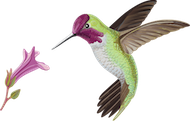As the Gottlieb Native Garden’s naturalist, Scott Logan documents the ever-changing array of wildlife species as they vary with the garden’s blooms, seasons and migratory patterns. While bringing these observations to life for all to experience, he also coordinates scientific research projects, and monitors the overall health and biodiversity of the garden. The Naturalist’s Journal also highlights the work the Gottliebs and Scott are doing to educate and inspire people to start gardening for wildlife with native plants.
Night Falls on the Garden
The transition between daylight and darkness is a magical time to be in the GNG. Here a well-camouflaged Great Horned Owl lurks in the shadows, getting in a few more winks before a night of hunting begins.
Frustrated Cooper’s Hawk
This young Cooper’s Hawk seems to know that these Mourning Doves are out of its reach, although he or she is still thinking about it. A Cooper’s Hawk’s hunting strategy relies solely on surprise. If the prey has noticed the hawk before the assault, odds […]
Monarch Chrysalises
Early morning sun shines on Monarch chrysalises, giving them the radiance of green jewels…
Hungry Horde is Welcome in the GNG
From the moment a Monarch caterpillar emerges from its egg, it is an eating machine (even consuming its empty egg shell!). Once a Monarch caterpillar has finished eating one leaf it moves to the next, and then the next, and then the next, until they […]
Final Hooded Orioles Have Departed
No orioles have been seen in the Gottlieb Native Garden for over two weeks now, so it seems that the last Bullock’s and Hooded Orioles have departed for Western Mexico. Good luck and godspeed – see you in March of 2016!
Another Interesting Use for UV Light
Scorpions keep themselves well hidden during the daylight hours, but at night they leave their lairs to hunt small ground-dwelling arthropods. Late in the summer they are very active and can be found quite easily. When exposed to ultraviolet light (we use a hand-held flashlight […]
Nighttime Ultraviolet Light Trap
A both fun and interesting way to observe insects at night is to set-up a UV light trap. The type of trap we set-up from time to time consists of a 4′ UV spectrum fluorescent tube with a thin white sheet draped over it. This […]
Many, Many Monarch Caterpillars
Monarch butterflies have been present in the GNG all spring and summer, but during this time very few larvae have been seen – until now. Over 75 caterpillars are currently munching away on nearly every milkweed plant in the garden! Like so many gardens in […]
Huge Moth Pays the Garden a Visit!
The GNG had a brief visit today by a conspicuous moth with an interesting name, the Black Witch. With a wing span of up to 6 inches, it the largest moth found north of Mexico. For the most part, it doesn’t breed here in California […]
102° in the Shade
We have been experiencing extreme temptures lately and the shallow fountain has been very popular with all the birds in the GNG! These two videos are interesting in that different species of birds choose to have bathing parties together. The first clip is mostly House […]

